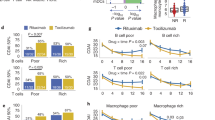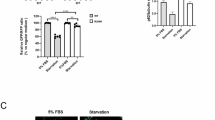Abstract
Rheumatoid arthritis (RA) is an autoimmune disease characterized by synovial inflammation and progressive joint destruction. Existing evidence indicates that hypoxia potentially contributes to the pathology of RA, though the specific mechanism remains unidentified. In this study, we explored the molecular mechanism through which the hypoxia-inducible factor (HIF-1α) contributed to the pathological process of RA. Our preliminary results suggested that hypoxia stimulates the activation of fibroblast-like synoviocytes (FLS) by inducing mitochondrial damage to activate cGAS-STING signaling, which can be effectively inhibited by silencing HIF-1α. In line with this, HIF-1α deficiency significantly alleviated the symptoms of collagen-induced arthritis (CIA) mice. RNA-Seq and CUT-Tag analysis revealed that HIF-1α down-regulated the expression of AlkB homologue 7 (ALKBH7) by acting on the ALKBH7 promoter site on chromosome 19 6372400-6372578. Using dual luciferase reporter analysis, we identified that ACCGTGGC as the motif to which HIF-1α bound directly. Subsequently, we demonstrated that knockdown of ALKBH7 induces mitochondrial damage and activates cGAS-STING signaling by downregulating the expression of UQCRC2. Conversely, overexpression of ALKBH7 could resist hypoxia-induced mitochondrial damage and FLS activation. In conclusion, HIF-1α triggers mitochondrial damage by downregulating the expression of ALKBH7 thereby promoting FLS activation, which may be the molecular mechanism by which hypoxia is involved in the pathological process of RA.

Hypoxia promotes the activation of FLS through the induction of mitochondrial damage, which subsequently activates cGAS-STING signaling. Mechanistically, HIF-1α triggers mitochondrial damage by downregulating the expression of ALKBH7 in a target manner. Furthermore, the deletion of ALKBH7 leads to mitochondrial damage under hypoxic conditions, primarily through the downregulation of UQCRC2, as opposed to other complexes.
This is a preview of subscription content, access via your institution
Access options
Subscribe to this journal
Receive 12 print issues and online access
$259.00 per year
only $21.58 per issue
Buy this article
- Purchase on SpringerLink
- Instant access to full article PDF
Prices may be subject to local taxes which are calculated during checkout






Similar content being viewed by others
References
Zhang Q, Liu J, Zhang M, Wei S, Li R, Gao Y, et al. Apoptosis induction of fibroblast-like synoviocytes is an important molecular-mechanism for herbal medicine along with its active components in treating rheumatoid arthritis. Biomolecules. 2019;9:795.
Petrovská N, Prajzlerová K, Vencovský J, Šenolt LFilková M. The pre-clinical phase of rheumatoid arthritis: From risk factors to prevention of arthritis. Autoimmun Rev. 2021;20:102797.
Wasserman AM. Diagnosis and management of rheumatoid arthritis. Am Fam Phys. 2011;84:1245–52.
Nygaard G, Firestein GS. Restoring synovial homeostasis in rheumatoid arthritis by targeting fibroblast-like synoviocytes. Nat Rev Rheumatol. 2020;16:316–33.
Bottini NFirestein GS. Duality of fibroblast-like synoviocytes in RA: passive responders and imprinted aggressors. Nat Rev Rheumatol. 2013;9:24–33.
de Oliveira PG, Farinon M, Sanchez-Lopez E, Miyamoto S, Guma M. Fibroblast-like synoviocytes glucose metabolism as a therapeutic target in rheumatoid arthritis. Front Immunol. 2019;10:1743.
Sabeh F, Fox D, Weiss SJ. Membrane-type I matrix metalloproteinase-dependent regulation of rheumatoid arthritis synoviocyte function. J Immunol. 2010;184:6396–406.
Cornelius MD, Leech SL, Goldschmidt L, Day NL. Is prenatal tobacco exposure a risk factor for early adolescent smoking? A follow-up study. Neurotoxicology Teratol. 2005;27:667–76.
Fearon U, Canavan M, Biniecka M, Veale DJ. Hypoxia, mitochondrial dysfunction and synovial invasiveness in rheumatoid arthritis. Nat Rev Rheumatol. 2016;12:385–97.
Chen J, Cheng W, Li J, Wang Y, Chen J, Shen X, et al. Notch‐1 and notch‐3 mediate hypoxia‐induced activation of synovial fibroblasts in rheumatoid arthritis. Arthritis Rheumatol. 2021;73:1810–9.
McGettrick AF, O’Neill LAJ. The role of HIF in immunity and inflammation. Cell Metab. 2020;32:524–36.
Fuhrmann DC, Brune B. Mitochondrial composition and function under the control of hypoxia. Redox Biol. 2017;12:208–15.
Gong T, Liu L, Jiang W, Zhou R. DAMP-sensing receptors in sterile inflammation and inflammatory diseases. Nat Rev Immunol. 2020;20:95–112.
Hopfner KP, Hornung V. Molecular mechanisms and cellular functions of cGAS-STING signalling. Nat Rev Mol Cell Biol. 2020;21:501–21.
Jiang M, Chen P, Wang L, Li W, Chen B, Liu Y, et al. cGAS-STING, an important pathway in cancer immunotherapy. J Hematol Oncol. 2020;13:81.
Bian K, Lenz SAP, Tang Q, Chen F, Qi R, Jost M, et al. DNA repair enzymes ALKBH2, ALKBH3, and AlkB oxidize 5-methylcytosine to 5-hydroxymethylcytosine, 5-formylcytosine and 5-carboxylcytosine in vitro. Nucleic Acids Res. 2019;47:5522–9.
Wu TP, Wang T, Seetin MG, Lai Y, Zhu S, Lin K, et al. DNA methylation on N6-adenine in mammalian embryonic stem cells. Nature. 2016;532:329–33.
Perry GS, Das M, Woon ECY. Inhibition of AlkB nucleic acid demethylases: promising new epigenetic targets. J Med Chem. 2021;64:16974–7003.
Zhang LS, Xiong QP, Pena Perez S, Liu C, Wei J, Le C, et al. ALKBH7-mediated demethylation regulates mitochondrial polycistronic RNA processing. Nat Cell Biol. 2021;23:684–91.
Hong Z, Tie Q, Zhang L. Targeted inhibition of the GRK2/HIF-1α pathway is an effective strategy to alleviate synovial hypoxia and inflammation. Int Immunopharmacol. 2022;113:109271.
Nunnari J, Suomalainen A. Mitochondria: in sickness and in health. Cell. 2012;148:1145–59.
Faas MMde, Vos P. Mitochondrial function in immune cells in health and disease. Biochim Biophys Acta. 2020;1866:165845.
Picca A, Calvani R, Coelho-Junior HJ, Landi F, Bernabei R, Marzetti E. Mitochondrial dysfunction, oxidative stress, and neuroinflammation: intertwined roads to neurodegeneration. Antioxidants (Basel). 2020;9:647.
Maekawa H, Inoue T, Ouchi H, Jao TM, Inoue R, Nishi H, et al. Mitochondrial damage causes inflammation via cGAS-STING signaling in acute kidney injury. Cell Rep. 2019;29:1261–73.e6.
Jedynak-Slyvka M, Jabczynska A, Szczesny RJ. Human mitochondrial RNA processing and modifications: overview. Int J Mol Sci. 2021;22:7999.
Barshad G, Marom S, Cohen T, Mishmar D. Mitochondrial DNA transcription and its regulation: an evolutionary perspective. Trends Genet. 2018;34:682–92.
Delaunay S, Pascual G, Feng B, Klann K, Behm M, Hotz-Wagenblatt A, et al. Mitochondrial RNA modifications shape metabolic plasticity in metastasis. Nature. 2022;607:593–603.
Acknowledgements
We acknowledge the technical support provided by Weihuan Biotechnology Co., Ltd. The research was funded by the National Natural Science Foundation of China (82204403 and 82373878), The Major Projects of the Anhui Provincial Department of Education (2023AH040080), the Anhui Provincial Natural Science Foundation (2308085MH312), and the Postgraduate Innovation Research and Practice Program of Anhui Medical University (YJS20230009).
Author information
Authors and Affiliations
Contributions
The majority of experiments, data analysis, and manuscript composition were conducted by HW, YCZ and LX. Synovial tissue from OA patients, as well as RA patients undergoing joint replacement, was provided by PP with the patients’ consent for the purposes of this study. Additional experiments were carried out by TJZ, LHL, MQZ, HZ, and YNY. The manuscript and figures underwent significant revisions and improvements under the guidance of LJ and ZWZ. XZZ and Pro. LLZ contributed their expertise to the experimental design, data processing, and manuscript writing. The final manuscript has been thoroughly reviewed and approved by all authors.
Corresponding authors
Ethics declarations
Competing interests
The authors declare no competing interests.
Additional information
Publisher’s note Springer Nature remains neutral with regard to jurisdictional claims in published maps and institutional affiliations.
Rights and permissions
Springer Nature or its licensor (e.g. a society or other partner) holds exclusive rights to this article under a publishing agreement with the author(s) or other rightsholder(s); author self-archiving of the accepted manuscript version of this article is solely governed by the terms of such publishing agreement and applicable law.
About this article
Cite this article
Wang, H., Zhao, Yc., Xu, L. et al. HIF-1α mediates mitochondrial damage by down-regulating ALKBH7 expression to promote the aberrant activation of FLS in rheumatoid arthritis. Acta Pharmacol Sin 46, 2225–2236 (2025). https://doi.org/10.1038/s41401-025-01520-y
Received:
Accepted:
Published:
Issue date:
DOI: https://doi.org/10.1038/s41401-025-01520-y



